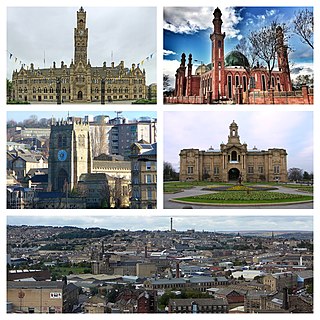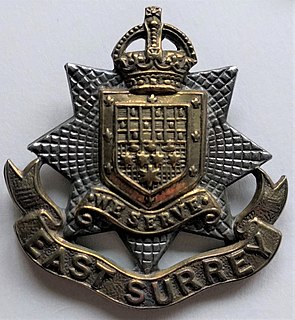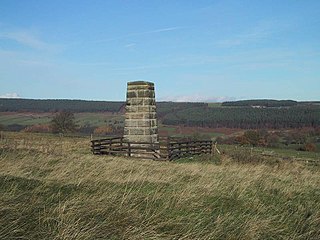 W
WThis is a list of pals battalions of the British Army during the First World War. Pre-war Territorial Force (T.F.) battalions have not been included, although they too usually recruited from a specific area or occupation. The 69 line infantry regiments formed 142 locally raised battalions and 68 local reserve battalions. The Guards Regiments and the regiments formed only from Territorial Force battalions did not form pals battalions.
 W
WThe Pals battalions of World War I were specially constituted battalions of the British Army comprising men who had enlisted together in local recruiting drives, with the promise that they would be able to serve alongside their friends, neighbours and colleagues, rather than being arbitrarily allocated to battalions.
 W
WBradford is the second-largest city in West Yorkshire, England. It forms the core of the City of Bradford metropolitan borough, which also includes the towns of Keighley, Shipley, Bingley and Ilkley, and borders the City of Leeds and Calderdale to the east and south respectively as well as the counties of Lancashire and North Yorkshire.
 W
WThe 12th (Service) Battalion of the Gloucestershire Regiment was a 'Pals battalion' of 'Kitchener's Army' raised immediately after the outbreak of World War I through the initiative of the City of Bristol. It saw action at the Somme, Arras and Ypres, before moving to the Italian Front. It returned to the Western Front to fight in the German spring offensive and the victorious Allied Hundred Days Offensive.
 W
WThe 13th (Service) Battalion (Wandsworth), East Surrey Regiment was a British New Army infantry battalion during the First World War. Formed in 1915 as a hostilities-only battalion, it was part of the East Surrey Regiment garrisoned at Witley, England. Going to France in 1916, it saw action at the battles of the Somme, Cambrai, Arras and the Lys.
 W
WThe Hull Pals were a brigade of four battalions of the East Yorkshire Regiment raised as part of Kitchener's Army in 1914. They served in 31st Division at Serre on the first day of the Battle of the Somme in 1916, though they escaped the worst of the disaster. However, they suffered heavy casualties in the same area later in the year, and again at Oppy Wood in early 1917. They continued to serve on the Western Front for the rest of the war, including hard fighting against the German spring offensive and in the final Hundred Days Offensive.
 W
WThe Hull Pals were a brigade of four battalions of the East Yorkshire Regiment raised as part of Kitchener's Army in 1914. They served in 31st Division at Serre on the first day of the Battle of the Somme in 1916, though they escaped the worst of the disaster. However, they suffered heavy casualties in the same area later in the year, and again at Oppy Wood in early 1917. They continued to serve on the Western Front for the rest of the war, including hard fighting against the German spring offensive and in the final Hundred Days Offensive.
 W
WThe Hull Pals were a brigade of four battalions of the East Yorkshire Regiment raised as part of Kitchener's Army in 1914. They served in 31st Division at Serre on the first day of the Battle of the Somme in 1916, though they escaped the worst of the disaster. However, they suffered heavy casualties in the same area later in the year, and again at Oppy Wood in early 1917. They continued to serve on the Western Front for the rest of the war, including hard fighting against the German spring offensive and in the final Hundred Days Offensive.
 W
WThe Hull Pals were a brigade of four battalions of the East Yorkshire Regiment raised as part of Kitchener's Army in 1914. They served in 31st Division at Serre on the first day of the Battle of the Somme in 1916, though they escaped the worst of the disaster. However, they suffered heavy casualties in the same area later in the year, and again at Oppy Wood in early 1917. They continued to serve on the Western Front for the rest of the war, including hard fighting against the German spring offensive and in the final Hundred Days Offensive.
 W
WThe Hull Pals were a brigade of four battalions of the East Yorkshire Regiment raised as part of Kitchener's Army in 1914. They served in 31st Division at Serre on the first day of the Battle of the Somme in 1916, though they escaped the worst of the disaster. However, they suffered heavy casualties in the same area later in the year, and again at Oppy Wood in early 1917. They continued to serve on the Western Front for the rest of the war, including hard fighting against the German spring offensive and in the final Hundred Days Offensive.
 W
WThe 17th (Service) Battalion, Middlesex Regiment was an infantry battalion of the Middlesex Regiment, part of the British Army, which was formed as a Pals battalion during the Great War. The core of the battalion was a group of professional footballers, which was the reason for its most commonly used name, The Football Battalion. The 23rd (Service) Battalion, Middlesex Regiment was formed in June 1915 and became known as the 2nd Football Battalion. The battalions fought in the Battle of the Somme in 1916 among others. Soldiers who fought in the 17th and 23rd Battalions included Second Lieutenant Walter Tull, who was possibly the first black infantry officer in the British Army.
 W
WThe 12th (Service) Battalion of the Gloucestershire Regiment was a 'Pals battalion' of 'Kitchener's Army' raised immediately after the outbreak of World War I through the initiative of the City of Bristol. It saw action at the Somme, Arras and Ypres, before moving to the Italian Front. It returned to the Western Front to fight in the German spring offensive and the victorious Allied Hundred Days Offensive.
 W
WThe 12th (Service) Battalion of the Gloucestershire Regiment was a 'Pals battalion' of 'Kitchener's Army' raised immediately after the outbreak of World War I through the initiative of the City of Bristol. It saw action at the Somme, Arras and Ypres, before moving to the Italian Front. It returned to the Western Front to fight in the German spring offensive and the victorious Allied Hundred Days Offensive.
 W
WThe Grimsby Chums was a British First World War Pals battalion of Kitchener's Army raised in and around the town of Grimsby in Lincolnshire in 1914. When the battalion was taken over by the British Army it was officially named the 10th (Service) Battalion, The Lincolnshire Regiment. It was the only 'pals battalion' to be called 'chums'.
 W
WThe Hull Pals were a brigade of four battalions of the East Yorkshire Regiment raised as part of Kitchener's Army in 1914. They served in 31st Division at Serre on the first day of the Battle of the Somme in 1916, though they escaped the worst of the disaster. However, they suffered heavy casualties in the same area later in the year, and again at Oppy Wood in early 1917. They continued to serve on the Western Front for the rest of the war, including hard fighting against the German spring offensive and in the final Hundred Days Offensive.
 W
WThe Leeds Pals were a First World War Pals battalion of Kitchener's Army raised in the West Yorkshire city of Leeds. When the battalion was taken over by the British Army it was officially named the 15th Battalion, The Prince of Wales's Own.
 W
WThe Liverpool Pals were Pals battalions formed during the First World War as part of the King's (Liverpool) Regiment. They, along with the Manchester Pals, are commemorated at a small memorial in France.
 W
WThe 17th (Service) Battalion, Middlesex Regiment was an infantry battalion of the Middlesex Regiment, part of the British Army, which was formed as a Pals battalion during the Great War. The core of the battalion was a group of professional footballers, which was the reason for its most commonly used name, The Football Battalion. The 23rd (Service) Battalion, Middlesex Regiment was formed in June 1915 and became known as the 2nd Football Battalion. The battalions fought in the Battle of the Somme in 1916 among others. Soldiers who fought in the 17th and 23rd Battalions included Second Lieutenant Walter Tull, who was possibly the first black infantry officer in the British Army.
 W
WThe 17th (Service) Battalion, Middlesex Regiment was an infantry battalion of the Middlesex Regiment, part of the British Army, which was formed as a Pals battalion during the Great War. The core of the battalion was a group of professional footballers, which was the reason for its most commonly used name, The Football Battalion. The 23rd (Service) Battalion, Middlesex Regiment was formed in June 1915 and became known as the 2nd Football Battalion. The battalions fought in the Battle of the Somme in 1916 among others. Soldiers who fought in the 17th and 23rd Battalions included Second Lieutenant Walter Tull, who was possibly the first black infantry officer in the British Army.
 W
WThe Tyneside Irish Brigade was a British First World War infantry brigade of Kitchener's Army, raised in 1914. Officially numbered the 103rd Brigade, it contained four Pals battalions from Newcastle upon Tyne, largely made up of men of Irish extraction..